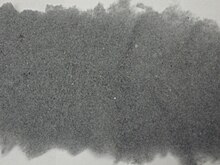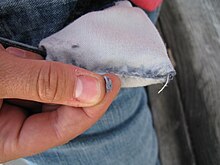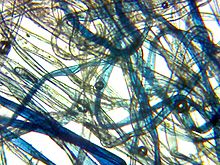| Lint | |
|---|---|
 Lint accumulation in the screen of a clothes dryer Lint accumulation in the screen of a clothes dryer | |
| Material type | Visible accumulations of textile fibers and other materials |
Lint is the common name for visible accumulations of textile fibers, hair and other materials, usually found on and around clothing. Certain materials used in the manufacture of clothing, such as cotton, linen, and wool, contain numerous, very short fibers bundled together. During the course of normal wear, these fibers may either detach or be jostled out of the weave of which they are part. This is the reason why heavily used articles, such as shirts and towels, become thin over time and why such particles accumulate in the lint screen of a clothes dryer.
Because of their high surface area to weight ratio, static cling causes fibers that have detached from an article of clothing to continue to stick to one another and to that article or other surfaces with which they come in contact. Other small fibers or particles also accumulate with these clothing fibers, including human and animal hair and skin cells, plant fibers, and pollen, dust, and microorganisms.
Etymology
The etymology of the modern word "lint" is related to "linting", the term used for the cultivation of the shorter fibers from the cotton plant (Gossypium), also called "lint", from which lower-quality cotton products are manufactured. Lint is composed of threads of all colors, which blend hues and may appear to be a uniform grey.
Varieties of lint
Cotton lint
Cotton lint refers to the fibrous coat that covers the cotton seeds. Cotton lint is ginned cotton. The term Linter: these are veritably short fibers which are not removed from seeds in the ginning process but are in special delinters machines at cotton ginning mill. The lint that is delivered to the spinning mill contains a variety of extraneous materials, including seed pieces, dust, and motes, which are collectively referred to as trash.
Dryer lint

Dryer lint is lint generated by the drying of clothes in a clothes dryer; it typically accumulates on a dryer screen. Underwriters Laboratories recommends cleaning the lint filter after every cycle for safety and energy efficiency. Failure to clean the lint filter is the leading cause of home clothes dryer fires.
Navel lint
Navel lint (also known by names such as navel fluff, belly button lint, belly button fluff, and dip lint) is an accumulation of fluffy fibers in the navel cavity often found at the beginning and end of the day. Cloth fibers are scraped by body hair via friction, which ratchets the fibers in the direction of hair growth. One hypothesis is that lint travels along a hair highway defined as integral curves of the vector field given by the direction of growth of the hair, which must end at a vanishing point according to the hairy ball theorem.
Pocket lint

Pocket lint (also known as gnurr) is debris including bits of fabric as well as small shreds of paper and tissue that are often found in pockets. It may sometimes be caused by running the clothing through a washing machine one or more times, causing the pocket lining or contents to compact and shred.
As pocket lint is an amalgamation of the contents of the pockets, pocket lint can be helpful when determining whether drugs have been previously stored in the pockets, by testing it with various drug tests. In a survival situation, pocket lint can be used as tinder for starting a fire.
The Infocom game, The Hitchhiker's Guide to the Galaxy, was sold with a collection of "props" that included a small bag of "pocket fluff".
Problems related to lint
Biological problems
Inhalation of excessive amounts of lint, as observed in early textile workers, may lead to diseases of the lungs, such as byssinosis. Lint shed from clothing during the course of wear may also carry bacteria and viruses. For this reason, the presence of lint presents a danger during surgery, when it might carry microorganisms into open wounds. It has been demonstrated that due to the abrasive contact between clothing and skin, "a person wearing a standard cotton scrub suit actually sheds more bacteria than without clothing". Lint is also a component of "toe jam", described as "that gunk located between your toes", which can result due to not properly cleaning feet and toes. Like ear wax, mucus, and many other bodily residues (...). But the issue can have several different causes—some of them more serious than others — so it pays to give your feet special attention." Lint also presents a threat to the environment in spaces that generally do not experience human contact, constituting "one of the primary polluters" in cave exploration.
Mechanical problems
Lint contamination also presents what may be the most serious threat of damage to delicate mechanical devices. In order to prevent lint contamination, workers entering clean rooms are generally required to wear an outer layer of clothing made from artificial fibers that are longer and thicker, and therefore much less likely to shed any material. Lint-resistant clothing materials include, elastic fabrics like spandex (or Lycra), for which the fibers will tend to stretch rather than break, and longer, stronger non-woven polyolefin fibers.
Other problems

Lint on clothing is generally considered unattractive and unprofessional. Furthermore, lint may be abrasive and may damage the clothing itself. For these reasons, visible lint is often removed with a lint remover or clothes brush. The accumulation of lint during clothes cleaning can be reduced with the use of a fabric softener, which reduces the amount of static electricity on clothing surfaces and therefore prevents the lint from sticking to the clothes.
Dryer lint, which collects on the lint screen of a clothes dryer, is highly flammable and therefore presents a fire hazard. However, because of this flammability, dryer lint may be collected for use as tinder, although burning human-made fibres can produce toxic fumes.
Uses of lint
Composting
It is possible to compost lint retrieved from the lint screen on a dryer by adding it to other materials being composted. The texture of the material allows the organic matter within it to compost quickly and easily. However, depending on the source, it may include inorganic fibers and materials which never break down.
Forensic science

Lint is useful to examine in forensic science because it is accumulated over time, and because the fibers shed from clothing adhere to not only that clothing, but also other particles to which the carrier is exposed. The lint on a person's clothing is therefore likely to contain material transferred from the various environments through which that person has passed, enabling forensic examiners to collect and examine lint to determine the movements and activities of the wearer. Examiners may use various chemicals to isolate lint fibers from different articles of clothing based on differences in color and other characteristics.
Tinder
Dryer lint burns readily. Although this may present a hazard in the household, it also means that lint makes excellent tinder for starting fires. It is especially useful for catching sparks from flint and steel, or similar striker-type fire starters in the absence of matches.
Wound treatment
Lint was used as a form of wound treatment for cuts and sores as early as 1500 BC and as recently as the American Civil War. Lint used specifically for treating wounds was sometimes referred to as charpie.
See also
References
- ^ Welker, R. W.; Nagarajan, Ramamurthy; Newberg, Carl E. (2006). Contamination and ESD Control in High-Technology Manufacturing. pp. 415–16.
- Hollen, Norma R.; Saddler, Jane (1952). Modern Textiles. p. 14.
- Glass, Don (October 16, 2008). "The Color of Lint". A Moment of Science. Indiana Public Media. Retrieved 26 March 2013.
- "Cotton Lint - an overview | ScienceDirect Topics". www.sciencedirect.com. Retrieved 2022-04-07.
- "Cotton lint Definition". Law Insider. Retrieved 2022-04-07.
- Underwriters Laboratories product safety tips – clothes dryers Archived 2014-03-05 at the Wayback Machine.
- "clothes dryer fire safety outreach materials", 'U.S. Fire Administration',
- Zollinger, Sue Anne (23 March 2011). "What Is Bellybutton Lint?". Indiana Public Media. Archived from the original on 13 November 2019. Retrieved 30 November 2020.
- Paul Dickson, Words: A Connoisseur's Collection of Old and New, Weird and Wonderful, Useful and Outlandish Words (1983), p. 182: "Gnurr. The substance that over time collects in the bottoms of pockets and the cuffs of trousers".
- ^ "Catching A Spark from Flint And Steel: Fire Building Basics", Prepper Bits, 30 September 2018.
- Blake Wilson (September 18, 2008). "'Hitchhiker's Guide': The Game "Arts Beat"". The New York Times.
- Yafa, Stephen (2006). Cotton: The Biography of a Revolutionary Fiber.
- Raheel, Mastura (1994). Protective Clothing Systems and Materials. p. 19.
- Kulkarni, G.S. (2008). Textbook of Orthopedics and Trauma. p. 296.
- URGENT CARE (October 20, 2015). "What Is Toe Jam?". upmc.com. Post updated May 11, 2016.
- Hurd, Barbara (2005). Entering the Stone: On Caves and Feeling Through the Dark. p. 54.
- Cochin, Ira (1963). Analysis and Design of the Gyroscope for Inertial Guidance. p. 143.
- Kozicki, Michael; Hoenig, Stuart A.; Robinson, Patrick J. (1991). Cleanrooms: Facilities and Practices.
- "The Inside Story on Outdoor Gear". Popular Science. Vol. 238, no. 5. May 1991. p. 82.
- Krishan Kumar Chawla (1998). Fibrous Materials. p. 102. ISBN 9780521570794.
- Cynthia Townley Ewer (2009). Houseworks. p. 139.
- Jeff Bredenberg (1999). Clean It Fast, Clean It Right. pp. 235–236.
- Eric Kleinert (1995). Troubleshooting and Repairing Major Appliances. TAB Books. p. 231. ISBN 9780070350786.
- Lori Baird (2007). Don't Throw It Out: Recycle, Renew and Reuse to Make Things Last. p. 216. ISBN 9781594865770.
- Wes Clark,"Everyday Household Materials Yield Toxic Smoke", FireAvert, 17 April 2015.
- Pleasant, Barbara; Martin, Deborah L. (2008). The Complete Compost Gardening Guide. p. 128.
- Jane Moira Taupin; Chesterene Cwiklik (2009). Forensic Examination of Clothing. p. 145. ISBN 9781420068214.
- Jane Moira Taupin; Chesterene Cwiklik (2009). Forensic Examination of Clothing. p. 195. ISBN 9781420068214.
- Mozayani, Ashraf; Noziglia, Carla (2006). The Forensic Laboratory Handbook: Procedures and Practice. p. 266.
- Jane Moira Taupin; Chesterene Cwiklik (2009). Forensic Examination of Clothing. p. 190. ISBN 9781420068214.
- Sweeney, Michael; Mayor, Mireya; Kayal, Michele (2009). National Geographic Complete Survival Manual. p. 46.
- "Notes of a European Tour". Buffalo Medical Journal. 2: 397. 1846.
External links and further reading
- Barker, Graham. "World record navel lint collection". feargod.net.
- "Bellybutton Lint Collecters". craftbits.com. 10 September 2007.
- Kruszelnicki, Karl (2001). "The Great Bellybutton Lint Survey". Australian Broadcasting Corporation. Q & A with Dr K.